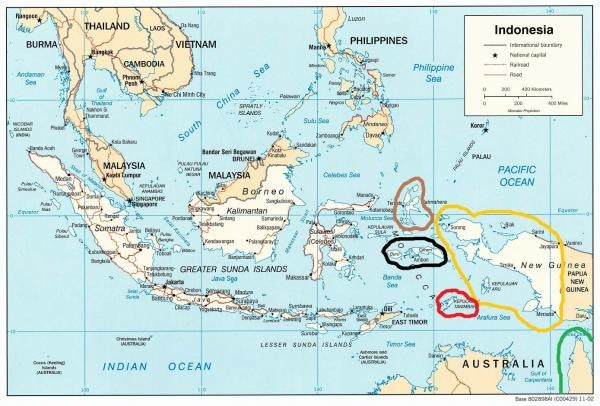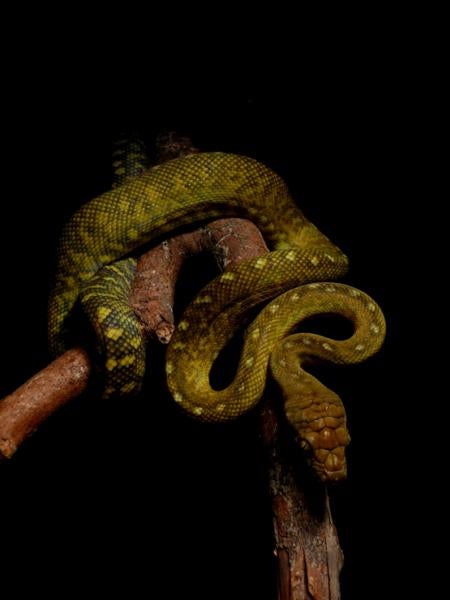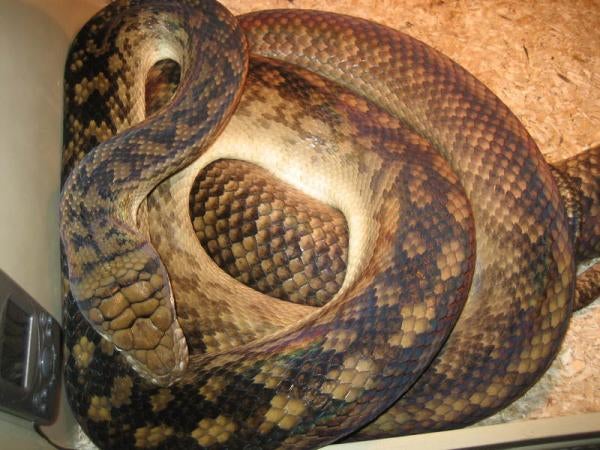There seems to be a fair amount of interest in scrub pythons, but allot of people tend to get confused over the various species and localities that are available.
I’ve written this guide in the hope that it will help people to better understand these beautiful and variable beasts.
As a side note, please feel free to add anything that you think I may have missed out.
THE SCRUB PYTHON COMPLEX
In 2000 Harvey, Barker, Ammerman and Chippindale wrote a paper on the scrub pythons, which up till then had been regarded as a single species Morelia amethistina, with one sub-species M.a kinghorni.
They concluded that the scrub pythons were actually a complex of snakes made up of five closely related species.
Below is a map and key showing where each species comes from
![Image]()
Brown - Morelia tracyae / Halmahera Island scrub python
Black - Morelia clastolepis / Moluccan Islands scrub python
Red - Morelia nauta / Tanimbar Islands scrub python
Gold - Morelia amethistina / New Guinea scrub python
Green - Morelia kinghorni / Queensland scrub python
The keen eyed amongst you will have spotted that I missed out the eastern half of New Guinea. The reason for this is that we have little to no data available to us regarding the scrubs from this part of the island. I will go in to more detail about this later.
A DESCRIPTION OF THE FIVE SPECIES
Morelia tracyae
![Image]()
The Halmahera Island scrub is a large python that grows to 10ft, possibly bigger. It feeds on mammals, birds and has been spotted frequenting fruit bat roosts. Little is known about its reproduction and it has not yet been bred in captivity. WC animals have a high mortality rate in captivity and are very rare.
Morelia clastolepis
Juvenile
![Image]()
Adult xanthic
![Image]()
Adult axanthic
![Image]()
The Moluccan Islands scrub is a large snake that can grow to 10-13ft. It has a beautiful pattern when young that fades a little as the animal matures. Two naturally occurring colour morphs are known.
Xanthic - Golden brown with gold eyes
Axanthic - Black with black eyes
They breed well in captivity and are fairly common.
Morelia nauta
Pattern less axanthic
![Image]()
Patten less xanthic
![Image]()
Patterned xanthic
![Image]()
The Tanimbar Islands scrub is the smallest of the complex not growing much over 6-7ft. It has four naturally occurring colour/pattern morphs.
Xanthic - Golden with golden eyes
Axanthic - Grey/brown with silver/golden eyes
Both these types can be un-patterned or patterned with small rosettes.
Its name nauta means sailor. This is because the islands it lives on have never been joined to any other so it could only have reached them by rafting. These have slowly started to become more available thru imports and small scale captive breeding.
Morelia kinghorni
![Image]()
The Queensland scrub is the largest of the complex averaging 15ft with a record of nearly 28ft. This makes it one of the longest snakes alive today. They are not legally exported from Australia so captive specimens are illegal, very hard to find and excessively expensive. They have been bred in very small numbers and I’m told there is a high mortality rate with the young.
Morelia amethistina
The authors of the 2000 paper felt that there could be a further four or five species hiding under this name, but did not have enough data to prove it. As it stands the West Papua (Irian Jaya) scrubs are broken up in to three "races".
Here is a map of West Papua showing their locations
![Image]()
Gold - Northern race "barnecks"
Grey - Central Highlands race
Brown - Southern race
A note on localities - Snakes are normally given the locality name of the town they are exported from. This does not mean they came from that particular town and were probably collected hundreds of miles away. We only use locality names as a "rough guide" to snakes that occur in that particular area of the country.
The Northern barnecks
These are some of the most commonly available scrubs in captivity. They can grow to 10ft + with some individuals hitting 16-17ft. They are characterized by having black bars on the labial scales and on the back of the head and neck. They can be patterned, pattern less or somewhere in between. The ground colour is golden brown to slightly greenish.
Here are some of the localities available -
Sorong
![Image]()
Manokwari
![Image]()
Jayapura
![Image]()
Kofiau Island
![Image]()
The Central Highlands
This area has two localities that have evolved isolated from the northern and southern forms. They grow to 10ft + and are rare in captivity.
Wamena
![Image]()
Oksibil
![Image]()
The Southerns
These are also very common in captivity and are large snakes growing 10-13ft +. They are also found on the Aru Islands where their patterning can be quite variable and, strangely, an isolated population occurs on Biak Island far to the north.
Here are a few of the localities available –
Merauke (these can be pattern less)
![Image]()
Aru Islands type 1
![Image]()
Aru Islands type 2
![Image]()
Biak Island
![Image]()
Papua New Guinea
M. amethistina occurs throughout this half of the island and on to the Bismarck Archipelago, but they remain poorly studied. It is thought that the northern, central and southern pattern trends continue into PNG and the pictures I’ve seen taken by O’Shea (one of very few people to have worked with these animals) seem to confirm this. He has also stated that he has seen strangely patterned scrubs like the tiger striped one he encountered on episode 6, series 2 of O’Shea’s Big Adventure. Barker also talks about a scrub from New Ireland that had a pinkish hew to its body. As PNG do not legally export any animals it’s doubtful we will see any of these scrubs in the flesh.
In my opinoin the scrub pythons are possibly the most interesting group of snakes available to private keepers. They are intelligent, fast and stunningly beautiful serpents!
I’ve written this guide in the hope that it will help people to better understand these beautiful and variable beasts.
As a side note, please feel free to add anything that you think I may have missed out.
THE SCRUB PYTHON COMPLEX
In 2000 Harvey, Barker, Ammerman and Chippindale wrote a paper on the scrub pythons, which up till then had been regarded as a single species Morelia amethistina, with one sub-species M.a kinghorni.
They concluded that the scrub pythons were actually a complex of snakes made up of five closely related species.
Below is a map and key showing where each species comes from

Brown - Morelia tracyae / Halmahera Island scrub python
Black - Morelia clastolepis / Moluccan Islands scrub python
Red - Morelia nauta / Tanimbar Islands scrub python
Gold - Morelia amethistina / New Guinea scrub python
Green - Morelia kinghorni / Queensland scrub python
The keen eyed amongst you will have spotted that I missed out the eastern half of New Guinea. The reason for this is that we have little to no data available to us regarding the scrubs from this part of the island. I will go in to more detail about this later.
A DESCRIPTION OF THE FIVE SPECIES
Morelia tracyae

The Halmahera Island scrub is a large python that grows to 10ft, possibly bigger. It feeds on mammals, birds and has been spotted frequenting fruit bat roosts. Little is known about its reproduction and it has not yet been bred in captivity. WC animals have a high mortality rate in captivity and are very rare.
Morelia clastolepis
Juvenile

Adult xanthic

Adult axanthic

The Moluccan Islands scrub is a large snake that can grow to 10-13ft. It has a beautiful pattern when young that fades a little as the animal matures. Two naturally occurring colour morphs are known.
Xanthic - Golden brown with gold eyes
Axanthic - Black with black eyes
They breed well in captivity and are fairly common.
Morelia nauta
Pattern less axanthic

Patten less xanthic

Patterned xanthic

The Tanimbar Islands scrub is the smallest of the complex not growing much over 6-7ft. It has four naturally occurring colour/pattern morphs.
Xanthic - Golden with golden eyes
Axanthic - Grey/brown with silver/golden eyes
Both these types can be un-patterned or patterned with small rosettes.
Its name nauta means sailor. This is because the islands it lives on have never been joined to any other so it could only have reached them by rafting. These have slowly started to become more available thru imports and small scale captive breeding.
Morelia kinghorni

The Queensland scrub is the largest of the complex averaging 15ft with a record of nearly 28ft. This makes it one of the longest snakes alive today. They are not legally exported from Australia so captive specimens are illegal, very hard to find and excessively expensive. They have been bred in very small numbers and I’m told there is a high mortality rate with the young.
Morelia amethistina
The authors of the 2000 paper felt that there could be a further four or five species hiding under this name, but did not have enough data to prove it. As it stands the West Papua (Irian Jaya) scrubs are broken up in to three "races".
Here is a map of West Papua showing their locations

Gold - Northern race "barnecks"
Grey - Central Highlands race
Brown - Southern race
A note on localities - Snakes are normally given the locality name of the town they are exported from. This does not mean they came from that particular town and were probably collected hundreds of miles away. We only use locality names as a "rough guide" to snakes that occur in that particular area of the country.
The Northern barnecks
These are some of the most commonly available scrubs in captivity. They can grow to 10ft + with some individuals hitting 16-17ft. They are characterized by having black bars on the labial scales and on the back of the head and neck. They can be patterned, pattern less or somewhere in between. The ground colour is golden brown to slightly greenish.
Here are some of the localities available -
Sorong

Manokwari

Jayapura

Kofiau Island

The Central Highlands
This area has two localities that have evolved isolated from the northern and southern forms. They grow to 10ft + and are rare in captivity.
Wamena

Oksibil

The Southerns
These are also very common in captivity and are large snakes growing 10-13ft +. They are also found on the Aru Islands where their patterning can be quite variable and, strangely, an isolated population occurs on Biak Island far to the north.
Here are a few of the localities available –
Merauke (these can be pattern less)

Aru Islands type 1

Aru Islands type 2

Biak Island

Papua New Guinea
M. amethistina occurs throughout this half of the island and on to the Bismarck Archipelago, but they remain poorly studied. It is thought that the northern, central and southern pattern trends continue into PNG and the pictures I’ve seen taken by O’Shea (one of very few people to have worked with these animals) seem to confirm this. He has also stated that he has seen strangely patterned scrubs like the tiger striped one he encountered on episode 6, series 2 of O’Shea’s Big Adventure. Barker also talks about a scrub from New Ireland that had a pinkish hew to its body. As PNG do not legally export any animals it’s doubtful we will see any of these scrubs in the flesh.
In my opinoin the scrub pythons are possibly the most interesting group of snakes available to private keepers. They are intelligent, fast and stunningly beautiful serpents!







